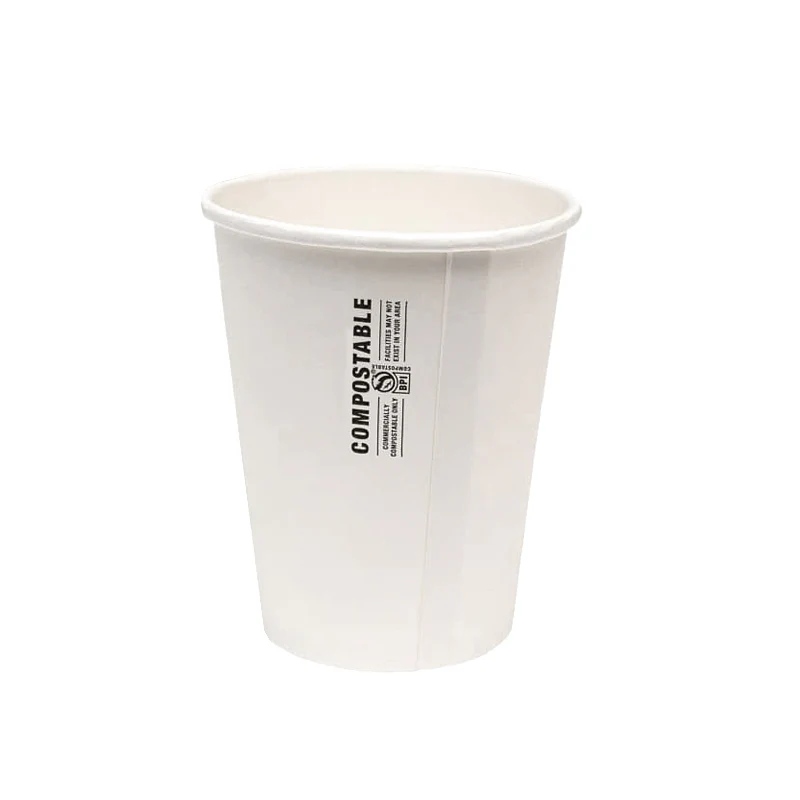Walk into any coffee shop today, and you’ll likely see bins labeled “compostable” and “recyclable” sitting side by side. You might even notice cups with green leaves and earth-friendly messaging promising to save the planet with every sip. But here’s the million-dollar question that’s confusing consumers everywhere: What’s the actual difference between compostable and recyclable coffee cups, and which choice truly makes a difference?
The answer isn’t as straightforward as you might think. In fact, the marketing messages surrounding these eco-friendly alternatives often obscure some important truths that every conscious consumer should understand. Today, we’re cutting through the greenwashing to give you the real story behind compostable and recyclable coffee cups.
The Great Coffee Cup Confusion
Before we dive into the differences, let’s address the elephant in the room: most traditional coffee cups aren’t actually recyclable, despite what many people believe. That innocent-looking paper cup from your favorite café? It’s lined with a thin layer of polyethylene plastic that makes it waterproof – and nearly impossible to recycle through conventional means.
This fundamental misunderstanding has led to massive contamination in recycling streams and countless “recyclable” cups ending up in landfills anyway. So when we talk about recyclable coffee cups, we’re discussing specially designed alternatives that can actually be processed through existing recycling infrastructure. You may also like to read The Economic Advantages of Sustainable Packaging for Businesses.
Recyclable Coffee Cups: The Technical Reality
What Makes a Cup Truly Recyclable?
True recyclable coffee cups are engineered specifically to work with existing recycling systems. The most promising innovations include:
Barrier Coatings:
- Water-based barriers that can be separated during recycling
- Specially formulated plastic linings designed to separate cleanly from paper
The Recycling Process: What Actually Happens
When a truly recyclable coffee cup enters the recycling stream, here’s what should happen:
- Collection and Sorting: Cups are separated from other materials
- Pulping: Paper fibers are broken down in water and chemicals
- Barrier Separation: The waterproof lining is removed or dissolved
- Cleaning: Contaminants are filtered out
- Fiber Recovery: Clean paper fibers are recovered for new products
The Reality Check: This process requires specialized equipment and facilities. Not all recycling centers can handle these cups, which means “recyclable” doesn’t always mean “will be recycled.”
Recycling Success Rates
Even with improved designs, recyclable coffee cup success rates vary dramatically:
- Best-case scenario: 60-70% actually get recycled in areas with proper infrastructure
- Average performance: 20-30% recycling rate in typical municipal systems
- Worst-case scenario: Less than 5% in areas without specialized facilities
Compostable Coffee Cups: The Biological Solution
Understanding Compostability
Compostable cups take a completely different approach. Instead of trying to work within existing recycling systems, they’re designed to biodegrade completely under specific conditions.
Materials Used:
- PLA (Polylactic Acid): Made from plant starch, coming from sugarcane, and other plant materials.
- PHA (Polyhydroxyalkanoates): Produced by microorganisms, fully biodegradable
- Bamboo fiber: Fast-growing renewable resource with natural binding agents
- Aqueous base:
The Composting Process
Compostable cups break down through biological processes:
- Microbial Action: Bacteria and fungi begin breaking down the material
- Molecular Breakdown: Complex polymers break into simple organic compounds
- Nutrient Release: Final products become soil-enriching compost
- Heat Generation: Decomposition creates heat (140-160°F in industrial facilities) for materials like PLA coatings.
However, compostable cups with aqueous coated, are recyclable and compostable. They are also said to be home compostable by some manufacturers
Timeline Variations:
- Industrial composting: 90-180 days under controlled conditions
- Marine environment: Some materials break down in 6-24 months
The Infrastructure Challenge
Here’s where compostable cups face their biggest hurdle: proper disposal infrastructure.
Industrial Composting Requirements:
- Temperature: Sustained 140-160°F for PLA coatings.
- Moisture: 50-60% humidity levels
- Oxygen: Regular turning for aerobic decomposition
- Time: Minimum 90-day processing cycles
Current Infrastructure Reality:
- Only 185 commercial composting facilities in the entire United States
- Limited residential access to industrial composting programs
- Geographic gaps leaving many communities without options
Head-to-Head Comparison: The Real Differences
Environmental Impact During Production
Recyclable Cups:
- Energy use: Similar to traditional cups (high energy for barrier coatings)
- Raw materials: Mix of virgin and recycled paper, specialized chemicals
- Water consumption: 0.4-0.6 liters per cup
- Carbon footprint: 0.09-0.12 kg CO2 equivalent per cup
Compostable Cups:
- Energy use: 20-40% less than traditional cups (plant-based materials)
- Raw materials: Renewable plant-based resources
- Water consumption: 0.3-0.5 liters per cup
- Carbon footprint: 0.06-0.09 kg CO2 equivalent per cup
End-of-Life Performance
Recyclable Cups (Best Case Scenario):
- Successful recycling: Material becomes new paper products
- Avoided waste: Keeps materials in the circular economy
- Timeline: Immediate reuse in new products
- Dependency: Requires functioning recycling infrastructure
Compostable Cups (Best Case Scenario):
- Complete biodegradation: Returns to natural elements
- Soil enrichment: Creates valuable compost for agriculture
- Timeline: 3-6 months in proper facilities
- Dependency: Requires industrial composting access
What Happens When Systems Fail
Recyclable Cups in Landfills:
- Decomposition time: Highly variable; often decades and in some cases much longer. While some sources cite ~20 years for paper cups with plastic liners as a rough figure, persistence depends on landfill conditions and can be longer.
- Environmental impact: Plastic linings (PE/HDPE) can release microplastics and leachable contaminants, especially with heat/contact. Learn more
- Methane production: Paper/organic components can decompose anaerobically in landfills and produce methane, a potent greenhouse gas if not captured
Compostable Cups in Landfills:
- Decomposition time: Compostable plastics (e.g., PLA) need industrial composting conditions (sustained high heat, oxygen) to biodegrade; in landfill environments they often degrade poorly or slowly.
- Environmental impact: They may still generate methane in anaerobic landfills because organic fractions decompose without oxygen
- Advantage: They can reduce the release of conventional petrochemical microplastics from PE liners, but claiming “no microplastic pollution” is too strong — bioplastics can fragment and their environmental behavior varies.
The Geographic Reality
Your location dramatically affects which option makes more environmental sense:
Urban Areas with Advanced Infrastructure
- Recyclable cups may perform better where specialized recycling exists
- Compostable cups work well where municipal composting programs operate
- Consumer education is crucial for proper disposal
Rural or Underserved Areas
- Compostable cups may be preferable (potential for home composting)
- Recyclable cups often end up in landfills due to infrastructure gaps
- Reusable options become even more important
International Considerations
- European markets often have better composting infrastructure
- Developing regions may lack both recycling and composting facilities
- Climate factors affect composting success rates
Consumer Behavior: The Human Factor
The most sustainable cup in the world won’t make a difference if consumers don’t dispose of it properly. Research shows:
Disposal Accuracy Rates:
- Recyclable cups: 40-60% disposed of correctly
- Compostable cups: 30-50% disposed of correctly
- Contamination issues: Wrong disposal can ruin entire batches
Education Impact:
- Clear labeling increases proper disposal by 25-40%
- Point-of-purchase education improves behavior significantly
- Consistent messaging across locations builds better habits
The Cost Factor
Recyclable Cups:
- Manufacturing cost: Typically higher than traditional cups, though the premium varies by region, volume, and technology. Some sources suggest around 10 % to 25 % extra in certain contexts (for example, plastic-free or recycled-content cups).
- Infrastructure investment: Requires recycling facility upgrades
- Long-term economics: Potential revenue from recovered materials
Compostable Cups:
- Manufacturing cost: Some sources state that plastic-free (e.g. PLA-lined) paper cups cost about 10 – 25 % more than conventional cups. (One site: “plastic-free cups seem 25% more expensive”)
- Infrastructure investment: Requires composting facility development
- Long-term economics: Compost has value, but markets are still developing
Making the Right Choice for Your Business or Lifestyle
For Coffee Shop Owners
- Assess local infrastructure – what waste processing is actually available?
- Educate customers about proper disposal methods
- Consider incentives for customers who bring reusable cups
- Partner with waste management to ensure proper processing
For Conscious Consumers
- Know your local systems – what actually gets processed in your area?
- Dispose properly – wrong bins defeat the purpose
- Support businesses that invest in sustainable options
The Bottom Line: Context Matters
The truth about compostable vs. recyclable coffee cups is that there’s no universal winner. The best choice depends on:
- Your local waste processing infrastructure
- Available disposal options
- Consumer education and behavior
- Long-term sustainability goals
What matters most is moving away from traditional disposable cups that end up in landfills regardless of good intentions.
Your Sustainable Coffee Journey Starts Here
Understanding the real differences between compostable and recyclable cups is just the first step. The most impactful choice you can make is investing in a high-quality sustainable cup regradless if is compostable or recyclable provides it eliminates the traditional disposable cups that end up in landfills.
Ready to make a lasting difference? Browse our sustainable coffee cup collection today and join thousands of coffee lovers who’ve already made the switch to truly sustainable sipping.



